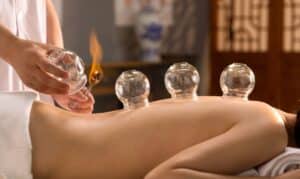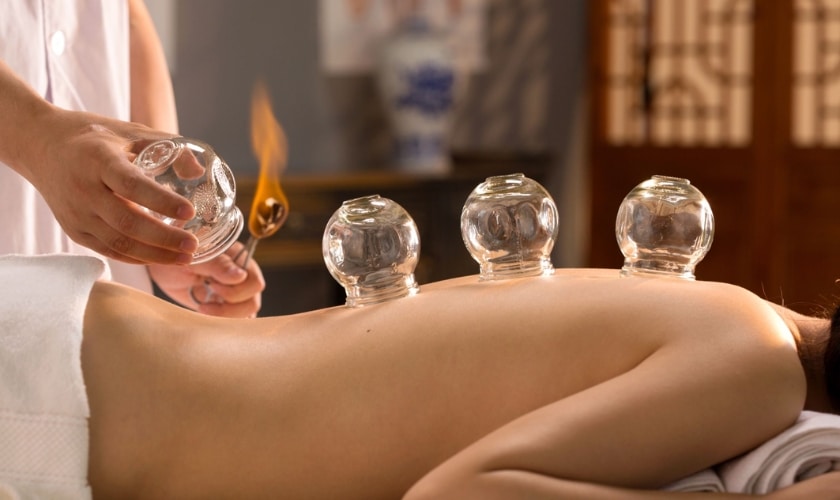Have you ever seen celebrities with circular red marks on their backs? Those are the telltale signs of cupping therapy, an ancient healing technique gaining popularity in recent times. But what exactly does a cupping therapist do?
This blog delves into the fascinating world of cupping therapy, exploring its history, the techniques used, the purported benefits, and the science behind it. We’ll also address potential side effects and help you decide if cupping therapy might be a suitable addition to your wellness routine.
A Peek into the Past: The Origins of Cupping Therapy
Cupping therapy boasts a long and illustrious history, dating back thousands of years. Evidence of cupping practices can be found in ancient civilizations like:
- Egypt: The Ebers Papyrus, a medical text from 1550 BC, mentions cupping therapy.
- China: Cupping has been a cornerstone of Traditional Chinese Medicine (TCM) for centuries.
- Greece: Hippocrates, the “father of medicine,” documented the use of cupping therapy in his writings.
- Middle East: Cupping therapy has been practiced in various cultures across the Middle East for centuries.
These historical references highlight the widespread use of cupping therapy throughout history for various ailments.
The Art of the Cup: Techniques Used in Cupping Therapy
Cupping therapy involves placing special cups on the skin and creating suction. Here’s a breakdown of the different techniques used:
- Dry Cupping: This is the most common technique. The therapist uses a glass, bamboo, silicone, or plastic cup to create suction on the skin. Suction can be created by:
- Heat: A flame is briefly applied inside the cup to create a vacuum before placing it on the skin.
- Manual Pump: A rubber pump is used to create suction within the cup placed on the skin.
- Wet Cupping: A less common technique, wet cupping involves creating suction and then using a small scalpel to make light, shallow incisions on the skin within the cupped area. A small amount of blood may be drawn out.
The cups are typically left in place for 5-15 minutes, depending on the technique and the desired therapeutic effect.
Beyond the Marks: The Purported Benefits of Cupping Therapy
Cupping therapy is used for a variety of purposes, including:
- Pain Relief: Cupping therapy is often used to relieve muscle pain, tension headaches, and chronic pain conditions like arthritis.
- Improved Circulation: The suction created by the cups is believed to promote blood flow to the area, potentially aiding in healing and reducing inflammation.
- Detoxification: Some proponents believe cupping helps eliminate toxins from the body, but there’s no scientific evidence to support this claim.
- Respiratory Conditions: Cupping therapy is sometimes used for coughs, congestion, and other respiratory issues.
- Athletic Performance: Some athletes use cupping to improve recovery and reduce muscle soreness.
While anecdotal evidence suggests benefits, more scientific research is needed to fully understand the effectiveness of cupping therapy for various conditions.
Unveiling the Science: Exploring the Potential Mechanisms of Cupping
The exact mechanisms behind cupping therapy’s purported benefits are still being investigated. Here are some potential explanations:
- Increased Blood Flow: The suction created by the cups might increase blood flow to the area, potentially aiding in healing and reducing inflammation.
- Pain Relief Through Nervous System Stimulation: Suction might stimulate nerve endings in the skin, potentially triggering the body’s natural pain-relieving mechanisms.
- Placebo Effect: Studies suggest the placebo effect might play a role in the pain relief experienced by some cupping therapy users.
More research is needed to definitively understand the science behind cupping therapy’s effectiveness.
Is Cupping Therapy Right for You? Considering the Potential Side Effects
Before trying cupping therapy, it’s important to consider the potential side effects:
- Bruising and Skin Discoloration: The suction can cause circular marks on the skin that typically fade within a few days.
- Discomfort: The cupping process might cause some discomfort or tightness in the treated area.
- Infection: There’s a slight risk of infection if non-sterile equipment is used.
- Not for Everyone: Cupping therapy is not recommended for people with certain medical conditions, pregnant women, or individuals with very thin or fragile skin.
If you’re considering cupping therapy, it’s crucial to consult with a licensed and qualified cupping therapist who uses sterile equipment. Discuss your medical history and any concerns you have before undergoing treatment.
Finding the Right Cupping Therapist: Qualifications and Considerations
Here are some pointers when searching for a qualified cupping therapist:
- Licensure: Look for a therapist who is licensed in your state and has certifications in cupping therapy from a reputable organization.
- Experience: Choose a therapist with experience in treating your specific condition or desired outcome.
- Hygiene: Ensure the therapist uses sterile equipment and maintains a clean treatment environment.
- Communication: Find a therapist who listens to your concerns and clearly explains the treatment process.
Don’t hesitate to ask questions and feel comfortable discussing your expectations with the therapist before proceeding.
Beyond Cupping: Exploring Alternative and Complementary Therapies
Cupping therapy is just one of many alternative and complementary therapies (ACT) gaining popularity. Here are some other ACT options you might consider:
- Acupuncture: This TCM technique involves inserting thin needles into specific points on the body to stimulate energy flow.
- Massage Therapy: Massage can help relieve muscle tension, pain, and promote relaxation.
- Yoga and Meditation: These practices can improve stress management, flexibility, and overall well-being.
- Ayurveda: This ancient Indian system of medicine focuses on promoting health and preventing disease through a holistic approach.
It’s important to note that ACTs are not meant to replace traditional medical care. They can be used alongside conventional treatments to enhance well-being and manage symptoms.
Conclusion: Unveiling the Potential of Cupping Therapy
Cupping therapy is an ancient technique experiencing a modern resurgence. While its effectiveness for various conditions needs further scientific exploration, it offers a potential non-invasive approach to pain relief and promoting circulation. If you’re curious about cupping therapy, consult your doctor and find a qualified practitioner to discuss if it’s suitable for your needs. Remember, a holistic approach to wellness that combines ACTs with conventional medicine might be the key to achieving optimal health.


